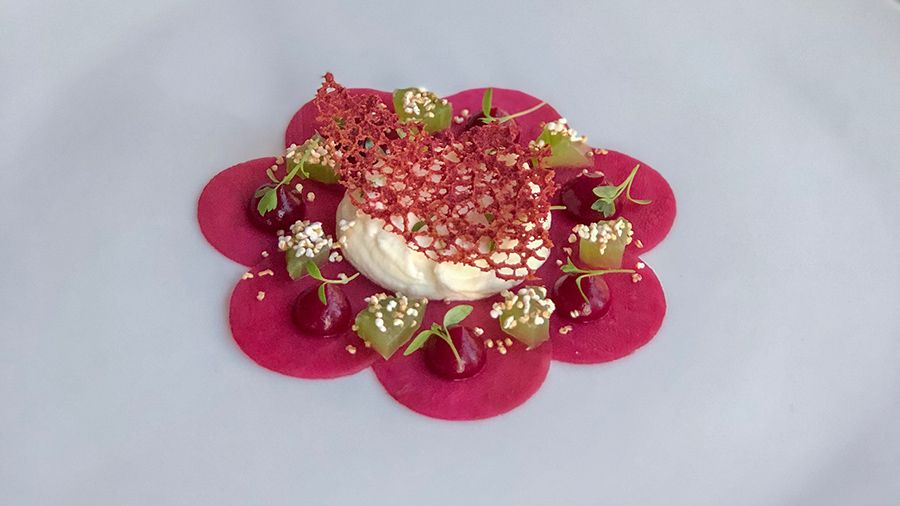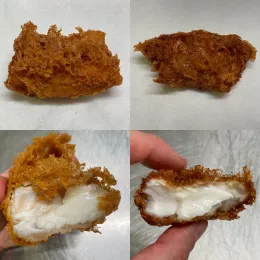When we eat, whether we are cognizant of it or not, we analyze every moment: temperature, taste, texture, color, mouthfeel and even the sound as we bite down and as we swallow. When we are creating food, our primary objective is to ensure that those moments make each dish delicious.
Sat Bains from Restaurant Sat Bains in Nottingham, eloquently says his job is to "f--- you up with flavor”. As chefs, when we combine elements for flavor, we have the opportunity to refine each ingredient's role with textural and visual effects.
A recent trip to a restaurant in Europe inspired me to think deeply about how I create dishes. I had an extremely simple dish as part of a tasting menu. As the small course arrived at the table, it was noted by the server that this dish was composed of really only two ingredients: tomato and celery. It seemed simple, but I could tell from the first bite that it comprised a complex thought process. It was indeed delicious, sweet, salty, slightly sour, a bold baseline of flavor. It hit all the aspects of a well-balanced and coherent dish. And it did more than that: The chef had clearly put a lot of thought into the texture of the dish. There were smooth, silky elements; a crunch; chew; and a light and airy component.
I left truly inspired and put in the work to create a like-minded dish of my own that would focus on a few main ingredients but with a nod to this mastery in texture that I experienced.
Here, I create a relatively simple beet dish. I make my own goat cheese, separating curds and whey and then form a light and airy mousse. I prepare beets several ways: lightly pickled slices with a tart and delicately crunchy texture and a beet gel infused with fennel, creating a super smooth and silky mouthfeel. My favorite part of the dish is what I call amaranth “popcorn.” The seed species of the Amaranthus plant has been cultivated for thousands of years and has recently made a significant impact globally. I gently toast the seed in a saucepan, carefully controlling the environment to allow these tiny seeds to puff into a popcorn-like puff.
To finish the dish, I make a crisp tuille of beet from a batter to create a “coral” effect. This element works in harmony with all of the other flavors and textures to make every bite interesting and thought-provoking.
The importance of creating flavorful food is clear. To push that to the next level, it is important to take every minor detail into consideration: texture, color and visual awareness combined with maximum flavor extraction. Here's my recipe to inspire your own detailed dish.
Goat Cheese Mousse, Pickled Beets, Beet Gel, Puffed Amaranth, Celery and Beet Coral

Pickled Beets

Ingredients
- 1 beet, cut in 4 cm rings and sliced 1 mm thick
- 200 grams raspberry vinegar
- 200 grams water
- 100 grams sugar
- 6 grams fennel seeds
- 4 Sarawak peppercorn s
- 1 fresh bay leaf
Directions
- Cook liquids and spices together for 5 minutes.
- Add sliced beets and infuse for 12 hours.
- Drain.
Beet Fluid Gel
Ingredients
- 2 beets, peeled and sliced 1 cm thick
- 20 grams raspberry vinegar
- Salt
- Sarawak pepper corn
- 3 grams fennel seeds
- 200 grams of prepared beet puree
- 1.8 grams or 0.9% agar
- 0.6 grams or 0.3% xanthan gum
- Bowl on top of ice water
Directions
- Peel and finely sliced beets.
- Add beets to polypropylene bag and season well with salt and pepper.
- Add 20 grams of raspberry vinegar and fennel seeds.
- Cook in water bath at 85 C for around 2 hours or until tender.
- Remove items from bag and place into a Vita-Prep.
- Blend on high until smooth.
- Check seasoning, adding more if needed.
- Add more vinegar if needed, it should have a slight acidic taste.
- Measure 200 grams of puree into a saucepan.
- Add xanthan gum and agar and disperse well.
- Heat mixture to 92 C and hold for 3 minutes at that temperature.
- Remove from heat and pour mixture into bowl over ice water to chill.
- The mixture should begin to set like jelly.
- Once set, scrape mixture into clean Vita-Prep and blend well until smooth.
- Place in a squeeze bottle for use.
- When piped the mixture should hold its shape and have a slight peak when lifted.
Amaranth “Popcorn”
Ingredients
- Amaranth
- Maldon sea salt
Directions
- Heat high-sided saucepan to 140 C.
- Add a single layer of amaranth raw.
- As soon as amaranth starts to pop, shake vigorously.
- Remove from heat and season.
Goat Cheese Mousse
Ingredients
- 75 grams cream (1), whipped
- 75 grams cream (2)
- 50 grams cream (3)
- 25 grams cream (4), cold
- 350 grams goat cheese
- 2.5 grams gelatin (silver)
- 8 grams lemon juice
- Black pepper
- Zest of 1 orange
Directions
- Whip 75 grams cream 1 to full peaks.
- Place goat cheese and cream 2 in the Robot Coupe and blend until smooth.
- Reserve 25 grams and store remainder.
- Bloom gelatin in iced water.
- Heat cream 3 and set aside, add gelatin to warm cream and dissolve, whisk until smooth.
- Add to 25 grams blended goat cheese and mix over ice to set.
- Add remaining goat cheese mixture and gelatin mixture.
- Fold in whipped cream gently.
- Add lemon juice and season well.
- Season with salt and black pepper.
- Add zested orange.
- Place into piping bag and leave in refrigerator until set.
Goat Curd and Whey
Ingredients
- 2 gallons goat milk
- 0.6 grams powdered rennet
- 1 packet chevre starter
Directions
- Heat milk to 86 F.
- Add rennet and starter.
- Mix well for 1 minute.
- Cover and leave for 12 hours.
- Strain curds to cheesecloth and hang.
- Reserve whey.
Beet and Fennel Tuille
Ingredients
- 40 grams beet juice
- 1 gram fennel essence
- 160 grams water
- 110 grams grapeseed oil
- 1 gram kosher salt
- 30 grams all-purpose flour
Directions
- Place water, beet juice, fennel essence and salt into a Vita-Prep.
- Blend on low creating a vortex.
- Add flour gradually until a thick paste has been achieved.
- Slowly add grapeseed oil.
- Heat a nonstick saucepan over medium heat.
- Add batter.
- Fry gently until all moisture has been evaporated and the mixture begins to set and deepen in color.
- Carefully remove tuille with a spatula and drain onto absorbent material.
Study Culinary Arts with Chef Barry at ICE's New York campus.




